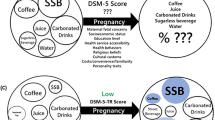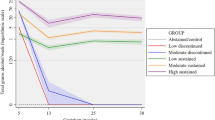Abstract
OBJECTIVE:
Determine the prevalence of substance use among pregnant women in five diverse communities utilizing the 4P's Plus© screen for alcohol, tobacco, and other drug use.
STUDY DESIGN:
Pregnant women enrolled in prenatal care clinics in five communities were screened for substance use with the 4P's Plus©. Those women with a positive screen underwent an assessment for substance use through a follow-up structured clinical interview conducted at the same prenatal visit.
RESULTS:
Among 7818 women in five communities, 2555 (32.7%) had a positive screen for substance use in pregnancy. Four of the communities conducted a follow-up assessment on all women with a positive screen (n=1548). Among these women, 717 (15% of the total population) had continued use after learning of the pregnancy. Overall, 21% of the pregnant women used alcohol prior to recognition of the pregnancy, and 11% continued use after knowledge of the pregnancy. Among the 512 women who continued to use alcohol, 2% were drinking daily, 7% were drinking 3 to 6 days per week, 27% were drinking 1 to 2 days per week, and 63% were drinking less than 1 day per week. The rates of marijuana use and other illicit drug use among the women were 7 and 2%, respectively, prior to knowledge of pregnancy and dropped to 3 and 1% after learning of the pregnancy.
CONCLUSION:
The 4P's Plus© identifies not only those pregnant women whose drinking or drug use is at a high enough level to impair daily functioning, but provides an opportunity for early intervention for the much larger group of women whose pregnancies are at risk from relatively small amounts of substance use.
This is a preview of subscription content, access via your institution
Access options
Subscribe to this journal
Receive 12 print issues and online access
$259.00 per year
only $21.58 per issue
Buy this article
- Purchase on Springer Link
- Instant access to full article PDF
Prices may be subject to local taxes which are calculated during checkout

Similar content being viewed by others
References
Chasnoff IJ, Burns WJ, Schnoll SH, Burns KA . Cocaine use in pregnancy. N Engl J Med 1985;313:666–669.
Shiono PH, Klebanoff MA, Nugent RP, et al. The impact of cocaine and marijuana use on low birth weight and preterm birth: a multicenter study. Am J Obstet Gynecol 1995;72:19–27.
Armstrong MA, Osejo VG, Lieberman L, Carpenter DM, Pantoja PM, Escobar GJ . Perinatal substance abuse intervention in obstetric clinics decreases adverse neonatal outcomes. J Perinatol 2003;23:3–9.
Frank DA, Bauchner H, Parker S, et al. Neonatal body proportionality and body composition after in utero exposure to cocaine and marijuana. J Pediatr 1990;117:622–626.
Chasnoff IJ, Anson A, Hatcher R, Stenson H, Iaukea K, Randolph L . Prenatal exposure to cocaine and other drugs: outcome at four to six years. In: Harvey JA, Kosofsky BE, editors. Cocaine Effects On the Developing Brain. New York, NY: Annals of the New York Academy of Science; 1998. p. 314–328.
Fried PA, Watkinson B . 36- and 48-month neurobehavioral follow-up of children prenatally exposed to marijuana, cigarettes, and alcohol. Dev Behav Pediat 1990;11(2):49–58.
Wekselman K, Spiering K, Hetteberg C, Kenner C, Flandermeyer A . Fetal alcohol syndrome from infancy through childhood: a review of the literature. J Pediatr Nurs 1995;10(5):296–303.
Sood B, Delaney-Black V, Covington C, et al. Prenatal alcohol exposure and childhood behavior at age 6 to 7 years: I. Dose–response effect. Pediatrics 2001;108(e34):1–9.
Morse B, Gehshan S, Hutchins E . Screening for substance abuse during pregnancy: improving care, improving health. National Center for Education in Maternal and Child Health. 1997.
Chasnoff IJ . Psychosocial Issues in Pregnancy. Washington, DC: American College of Obstetrics and Gynecology; 2002.
Ewing J . Detecting alcoholism: the CAGE questionnaire. JAMA 1984;252:1905–1907.
Kitchens JM . Does this patient have an alcohol problem? JAMA 1994;272:1782–1787.
Bottoms SF, Martier SS, Sokol RJ . Refinements in screening for risk drinking in reproductive-aged women: the “NET” results. Alcoholism 1989;13:339.
Sokol RJ, Martier SS, Ager JW . The T-ACE questions: practical prenatal detection of risk-drinking. Am J Obstet Gynecol 1989;160:863–868.
Russsell M, Martier SS, Sokol RJ, et al. Screening for pregnancy risk-drinking: TWEAKing the tests. Alcsm Clin Exp Res 1991;15:368 abstract no. 338.
Russell M, Martier SS, Sokol RJ, et al. Screening for pregnancy risk-drinking. Alcsm Clin Exp Res 1994;18:1156–1161.
Chan AW, Pristach EA, Welte JW, Russell M . Use of the TWEAK test in screening for alcoholism/heavy drinking in three populations. Alcsm Clin Exp Res 1993;17:1188–1192.
Howell E, Heiser N, Thornton C, Moreno L, Chasnoff IJ, Hill I . Third Annual Report: Evaluation of the Demonstration to Improve Access to Care for Pregnant Substance Abusers. Washington, DC: Mathematica Policy Research; 1996.
Chasnoff IJ, Hung WC . The 4P's Plus. Chicago: NTI Publishing; 1999.
Chasnoff IJ, Neuman K, Thornton C, Callaghan MA . Screening for substance use in pregnancy: a practical approach for the primary care physician. Am J Obstet Gynecol 2001;184:752–758.
Chasnoff IJ, Hutchins E . Motivating Providers to Screen for Alcohol Use in Pregnancy. Philadelphia, PA: American Public Health Association; 2002.
Johnson BT . DSTAT: Software for the Meta-Analytic Review of Research Literatures. Hillsdale, NJ: Lawrence Erlbaum Associates; 1989.
National Institute on Drug Abuse. National Pregnancy and Health Survey: Drug Use among women Delivering Live Births: 1992. Rockville, MD: US Department of Health and Human Services; 1996.
Chasnoff IJ, Landress HJ, Barrett ME . The prevalence of drug or alcohol use during pregnancy and discrepancies in mandory reporting in Pinellas County, Florida. N Engl J Med 1990;322:1202–1206.
Clark CM, Li DC, Conry J, Loock R . Structural and functional brain integrity of Fetal Alcohol Syndrome in Nonretarded Cases. Pediatrics 2000;105:1096–1099.
Larrson G . Prevention of fetal alcohol effects: an antenatal program for early detection of pregnancies at risk. Acta Obstet Gynecol Scand 1983;62:171–178.
Chasnoff IJ, Griffith DR, MacGregor S, Dirkes K, Burns KA . Temporal patterns of cocaine use in pregnancy: perinatal outcome. JAMA 1989;261(12):1741–1744.
Perl Harold I . Numerous studies demonstrate effectiveness of brief interventions. Frontlines, November NIAAA, 2000.
U.S. Preventive Services Task Force Ratings: Strength of Recommendations and Quality of Evidence. Guide to Clinical Preventive Services, Third Edition: Periodic Updates, 2000–2003. Rockville, MD: Agency for Healthcare Research and Quality; http://www.ahrq.gov/clinic/3rduspstf/ratings.htm.
ACOG Committee on Ethics. At-risk drinking and illicit drug use: Ethical issues in obstetric and gynecologic practice. ACOG Committee Opinion No. 294. American College of Obstetricians and Gynecologists. Obstet Gynecol 2004;103:1021–1031.
Author information
Authors and Affiliations
Additional information
Supported in part by grants to: Children's Research Triangle from Maternal Child Health Bureau, Health Resources and Services Administration, US Department of Health and Human Services Number 1H51MC00013; San Luis Obispo County Public Health Department, Family Health Services Division from First 5 San Luis Obispo, San Luis Obispo, CA, USA; and Southern Illinois Healthcare Foundation Healthy Start from Maternal Child Health Bureau, Health Resources and Services Administration, US Department of Health and Human Services Numbers 5H49MC00049-03 and 5H75MC00010-030
Rights and permissions
About this article
Cite this article
Chasnoff, I., McGourty, R., Bailey, G. et al. The 4P's Plus© Screen for Substance Use in Pregnancy: Clinical Application and Outcomes. J Perinatol 25, 368–374 (2005). https://doi.org/10.1038/sj.jp.7211266
Published:
Issue Date:
DOI: https://doi.org/10.1038/sj.jp.7211266
This article is cited by
-
Screening for Alcohol Use in Pregnancy: a Review of Current Practices and Perspectives
International Journal of Mental Health and Addiction (2023)
-
Elevated serum lead levels in neonates born to mothers suffering from opiate use disorder
Wiener Medizinische Wochenschrift (2022)
-
Patient Perceptions of Three Substance Use Screening Tools for Use During Pregnancy
Maternal and Child Health Journal (2022)
-
Prenatal Substance Use and Perceptions of Parent and Partner Use Using the 4P’s Plus Screener
Maternal and Child Health Journal (2019)



